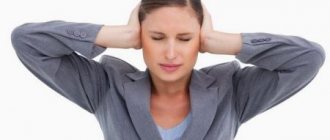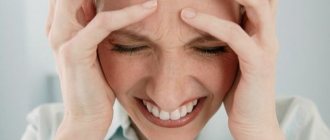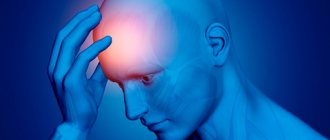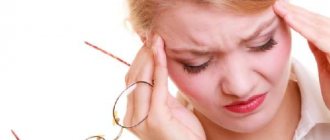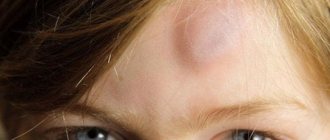Many people, regardless of age and social status, complain of discomfort and tension in the head. An unpleasant condition interferes not only with normal work and household chores, but also with restful sleep. Why does such a disorder occur and how to get rid of it?
Almost all people are susceptible to stress and may experience unpleasant emotions when communicating. If a person has to live for a long time in uncomfortable conditions, constantly experiencing negativity, then sooner or later the nervous system will fail. In addition, vascular diseases, tension headaches, and constant muscle strain may occur. To understand the reasons for the malaise, you need to consult a doctor. He will prescribe appropriate treatment and give recommendations.
Causes of tension
Constant tension and pain in the head can be caused by:
- Neurotic conditions, neurosis.
- Regular strain of the neck muscles.
- Disorder in the functioning of cerebral vessels.
- Overwork.
It is very important to identify the causes of tension in time and get rid of them. Otherwise, it can develop into severe neurosis. Experts note that unpleasant sensations in the head are both primary and secondary in nature.
With vegetative-vascular dystonia, victims complain of tension, pressure from inside the head, surges in blood pressure, increased sweating, hand tremors, and intestinal problems. This condition can occur in both children and adults. The cause of the development of pathology can be overwork, poor nutrition, hormonal imbalance, and cervical osteochondrosis.
Elderly people with cerebral atherosclerosis and hypertension also experience headaches. Here you can help patients by curing the underlying disease.
Secondary tension headaches can occur with:
- Sinusitis.
- Osteochondrosis of the neck.
- Eye diseases.
- Myositis.
Tension in the head and neck area can occur when a person holds an uncomfortable position for a long time. The neck muscles become overstrained, vascular spasm occurs, and pain impulses are sent to the brain. Then headaches are added to the tension.
There is another cause of discomfort - neurosis. In this condition, a person loses the ability to tolerate stress and control emotions. The nervous system is gradually depleted, which causes problems of both mental and neurological nature.
Classification of painful and tense sensations in the head
Neurotic pain has its own characteristics: everyone can feel it differently, depending on the location of the concentration of pain. There are migraine, chronic and tension types of headaches.
Cephalgia may appear for the following reasons:
- severe muscle “tightness”;
- pathological disruptions in the functioning of cerebral vessels;
- idiopathic pain that occurs without disruptions in the functioning of blood vessels and muscles.
If pain and tension in the head during neurosis are caused by general muscle tightness (neuromuscular pain), then they will manifest themselves as follows:
- the head is heavy, as if shackled with a thick hoop or hat, some parts of it are numb;
- neck muscles are tight, it is impossible to relax;
- the skin of the scalp and part of the face reacts painfully to touch;
- pain has a linear distribution (up or down);
- severity level – moderate;
- localization – tension covers the entire head;
- duration - from several hours to several days.
With constant tension in the head, a person literally does not know what to do and what to do to distract himself from unpleasant sensations. Its manifestations block all cognitive abilities: it is difficult to engage in mental work, memory deteriorates, and attention is distracted.
If the cause of cephalgia is a malfunction in the functioning of the brain vessels, the condition will be something like this:
- unpleasant pain impulses in the temples, forehead and back of the head;
- noise in the head;
- pulsation takes over all your attention, preventing you from distracting yourself from pain and performing intellectual tasks;
- in some cases, severe weakness and nausea appear.
If cephalalgia appears without disruptions in the functioning of blood vessels and muscle tension, its most likely cause is severe moral and physical fatigue. Such pain has no localization or specific description; it appears as a result of experiences of a psycho-emotional nature (and therefore it can be classified as symptoms of neurosis).
Symptoms
In neurotic disorders, the following types of pain are distinguished:
- Neuromuscular . It causes a feeling of compression of the skull.
- Neurovascular. Has a pulsating character.
With regular muscle strain, the disorder manifests itself:
- Heaviness in the head.
- Tightness of the neck muscles.
- Soreness of the scalp.
The pain is intense and affects the entire head. The attack can last quite a long time. The victim, due to a sore head, does not know how to relieve tension and distract himself from the discomfort. It is difficult for him to do any work, his memory and attention noticeably deteriorate.
If the main cause of tension is problems with the cerebral vessels, then the following occurs:
- Painful sensations in the temples, frontal and occipital parts.
- Noise, ringing in the ears.
- Lethargy.
- Sensation preceding vomiting.
If an attack flares up for no apparent reason, then it is probably triggered by severe overwork. Such pains have no localization and specific symptoms. Since this pain is of a psycho-emotional nature, it is classified as a neurotic condition.
Patients with neurosis experience:
- Increased sweating.
- Frequent heartbeat.
- Appetite disorders.
- Dizziness.
- Anxiety.
- Unreasonable fear.
- Fast fatiguability.
- Mood swings.
- Tearfulness.
- Dyspnea.
- Numbness of the limbs.
Interestingly, dizziness during neurosis has nothing to do with the functioning of the body. The dependence of its occurrence on the emotional state has been proven. Psychogenic dizziness begins with depression, panic attacks, and phobias.
Symptoms of neurosis
A nervous system disorder is characterized by a disturbance in a person’s psychological balance and physical activity.
The reasons for such violations:
- any event that traumatizes the psyche;
- chronic nervous tension;
- the impact on the psyche of a very joyful event (the birth of a child).
Factors causing neurosis:
- psychological (life in society, personal development);
- biological (insufficiency of certain neurophysiological as well as neurotransmitter systems, a person is susceptible to nervous disorders).
The disease manifests itself with one or more symptoms:
- headaches or dizziness;
- numbness of the limbs;
- insomnia;
- tense state;
- irritability, nervousness;
- depression, panic attacks;
- anxiety, obsessiveness;
- decreased mental activity;
- feeling of fear;
- loss of appetite and insufficient salivation;
- spots or circles before the eyes;
- dyspnea;
- lack of sexual desire;
- unstable blood pressure;
- sweating;
- sensitive perception of changes in temperature, light;
- mood swings;
- physical fatigue.
In some cases, patients report experiencing all the symptoms.
Classification and signs of nervous tension
In order to respond to your body’s signals in a timely manner, you need to know what types of tension there are.
- Light . Occurs in most people. During the day a person faces many problems. He gets irritated, angry, and remembers something unpleasant when meeting people he doesn’t like. But pleasant events quickly erase obsessive thoughts from memory, and the mood improves.
- Increased . Noticeably takes away the patient's strength. At the same time, an unsuccessful solution to some complex problem, experiencing stress, as well as constant mental work (for example, in people involved in serious business or politics) can cause an uncomfortable feeling.
- Strong . Has a negative impact on the patient's psyche. Signs of neurosis, dizziness and other symptoms appear, including loss of appetite, cephalgia, weakness, lethargy.
A person experiencing nervous tension experiences:
- Stiffness.
- Overexcitement.
- Aggression.
- Nervousness.
If the feeling of tension does not go away on its own, the sensations intensify, you need to take all possible measures to eliminate the disorder.
Tension headache: how to help?
According to the latest World Burden of Disease Survey, 1.5 billion people on the planet periodically suffer from this disease.
What is a tension headache
Tension headache is a separate disease. It is not characterized by the occurrence of a precursor aura (intolerance to various smells, sounds, light, etc.), vomiting and focal neurological disorders (changes in speech, numbness of the limbs, etc.). The only thing that bothers me is the headache. This is an important difference from other cephalgia (headaches), primarily from migraine, with which tension headache is often confused.
Characteristic signs of the disease will help you understand what a tension headache is:
1. The head hurts on both sides, the nature of the pain is pressing or squeezing. It seems as if the head is shackled with a “hoop” or “helmet”.
2. The pain is of mild or moderate intensity, and there is never any throbbing in the head. Because of this, a person retains the ability to perform professional tasks, but work productivity, of course, is reduced.
3. The pain is not worsened by physical activity such as walking or climbing stairs.
If you're dealing with headaches, check out these signs to help yourself!
Why do tension headaches occur?
Tension headaches are faced mainly by responsible people of intellectual work.
Neurologists identify a number of risk factors:
• anxiety and depressed mood, concern for yourself and loved ones;
• stressful and conflict situations at work and in the family;
• lack of rest;
• burnout syndrome – a person feels morally, physically and mentally exhausted;
• prolonged static posture for office workers, for example, sitting at a computer.
Most often, people at the most productive age – 30-60 years – experience tension headaches. And this entails unfavorable socio-economic consequences - isolation, reluctance to communicate, decreased earnings, etc. If you notice that at least one of the risk factors is present in your life, take care of its quality in advance. Don't wait for the effects of tension headaches to hit you!
How does a tension headache appear?
The emotional factor is one of the most important in the origin of tension headaches, which changes the metabolism in nerve cells, they become more vulnerable and less protected. At the same time, muscle tone may increase with the appearance of painful tension (felt when palpating the muscles of the back of the neck, temporal masseter, sternocleidomastoid). This is how a vicious circle is formed: stress – muscle-tonic tension – pain syndrome.
The pathological links in this chain look like this:
• poor circulation of the head muscles;
• excessive excitation of spinal neurons;
• increased sensitivity of pain receptors;
• increased pain.
Therefore, it is so important to restore nerve cells to normal condition in order to avoid the appearance of tension headaches and prevent its progression. If you do nothing and put up with the situation, over time, episodic pain becomes chronic.
How to protect yourself from headaches
If you constantly encounter risk factors, then it is more effective to prevent a headache than to treat it later. Expert doctors in the field of neuro-mental health advise following 3 simple rules to reduce the risk of developing tension headaches.
Relax after work
Lack of rest negatively affects the state of the nervous system; it is constantly in an excited state. It’s not for nothing that weekends were invented; dedicate them to yourself and your family. If you’ve worked for 5 days, go to the dacha or go to the cinema or to a concert of your favorite artist. The gym is also an excellent way to relieve psycho-emotional stress.
Get enough sleep
Night sleep should last about 8 hours. During this time, the metabolism in neurons has time to recover, and the brain is prepared to implement new tasks.
However, you need to sleep correctly. The room should be dark - turn off the floor lamps and close the curtains. Only in complete darkness does the synthesis of melatonin begin, a hormone that regulates circadian rhythms, promotes rejuvenation of the body and determines our level of activity. That’s why it’s so important not to use gadgets in bed – the blue glow from their screens blocks the synthesis of melatonin and complicates the process of falling asleep.
Start taking care of your health
Studies have shown that tension headaches often occur in people who generally do not take good care of their health. Make it a habit to visit your personal doctor at least once a year. This will allow you to identify any abnormalities in the functioning of your body at the earliest stages, when a short course of treatment will be enough to correct them.
What to do if you have a tension headache
It is important to understand what you want - to quickly help yourself and face pain again, or to ensure a long-term effect.
To stop attacks, neurologists recommend taking emergency medications - for example, non-steroidal anti-inflammatory drugs. However, in addition to the short-term effect, there is another negative side to the excessive use of symptomatic painkillers. Patients who regularly consume analgesics develop a chronic type of pain 2 times faster, and over time it becomes more and more difficult to find an effective means of pain relief.
It is much wiser to take care of preventing headache attacks. For this purpose, a group of nootropic drugs (or simply nootropics) has been created that restore the normal state of nerve cells, help strengthen and restore the functions of the nervous system that are impaired due to psycho-emotional stress.
What nootropic drugs are there?
Picamilon
It has an active effect - improves blood flow in the brain and promotes vasodilation. Helps normalize the psycho-emotional sphere, and when used as a course, reduces the manifestations of emotional stress.
Glycine
Refers, rather, to analogues of nootropics. Helps improve well-being and tone. According to the manufacturer, the drug promotes good sleep, protects against stress, and improves neuronal metabolism. The drug is often used to combat hypoxic conditions of nervous tissue.
Piracetam
One of the first nootropic drugs. It has been used successfully for many years, but more modern means now exist.
Cortexin
One of the modern nootropic drugs. The drug has proven itself both for the treatment of tension headaches and for the prevention of attacks. Cortexin reduces the psychogenic component responsible for the development of tension headaches. In addition, the drug improves cognitive functions (memory, attention, thinking) and protects neurons from toxic factors. According to research results, a ten-day course of drug therapy retains the effect for up to six months.
What besides drugs?
In addition to drug therapy, a head massage will be useful at the time of an attack. Lie down in bed, try to relax and drive away disturbing thoughts. Using your index and middle finger, use rotational movements, centimeter by centimeter, to massage your temples, forehead, and muscles of the back of your neck. This can improve blood flow, remove under-oxidized waste products and reduce spasm. It is recommended to continue the massage for 10-15 minutes.
For an even more relaxing effect, you can brew yourself herbal tea. Nonspecific sedative action in combination with other measures will help the nervous system relax and break the vicious circle of headaches. It’s good if after all these activities you manage to fall asleep. Sleep is the best way to restore the functional state of nerve structures.
However, remember, if you or your relatives periodically experience headaches, contact a neurologist to prescribe effective treatment.
Diagnostics
A pediatric neurologist treats tension pain in the head in children. If the problem occurs in an adult, he needs to contact a neurologist. After collecting anamnesis and examining the patient, the doctor can send him for diagnostics:
- X-ray of the neck.
- Computed or magnetic resonance imaging.
- Rheoencephalography.
- Ultrasound examination of blood vessels.
The main thing is to find the root cause of the disorder in order to get rid of unpleasant symptoms.
How to relieve tension in your head?
Tension in the head is not only a symptom of neurosis, but also its harbinger. Therefore, it is important to act immediately as soon as unpleasant sensations appear. Contact a doctor who will conduct a diagnosis at a medical facility. This will not only relieve you from unpleasant tension, but will also prevent possible disastrous consequences.
To relieve tension in your head yourself, follow these steps:
- focus on relaxing and relieving tension;
- switch your attention to objects that evoke positive emotions in you (if negative emotions do not leave you, do not resist them, but ignore them);
- take a contrast shower, go to the pool or other water treatments;
- creative activities (drawing, embroidery, wood burning);
- shift the focus to another problem that requires less emotional investment from you.
Interesting: Why do I have headaches for several days in a row?
If it comes to neurosis, then complex therapy will be required.
Methods for relieving head tension during neurosis:
- drug treatment;
- psychotherapeutic assistance;
- change in lifestyle;
- physiotherapy;
- phytotherapeutic methods.
Drug treatment
When tension in the head or pain causes severe discomfort or becomes unbearable, you can get rid of neurological pain using medication prescribed by your doctor.
For this therapy the following drugs are used:
- antispasmodics (relieve spasms) and analgesics;
- sedatives (plant based);
- drugs that stimulate brain activity (glycine);
- vitamins and minerals (magnesium, iron).
Medicines are used only as prescribed by a doctor. Painkillers hide the symptoms, and their long-term use makes the disease chronic. Tranquilizers are addictive.
If the pain is caused by nervous tension, then the use of medications will temporarily mask the pain, so replace medications with vitamins, rest and physical activity.
Consultation with a psychotherapist
To get rid of tension and other symptoms of neurosis, as well as eliminate the cause of the disease, consult a psychotherapist to prescribe complex therapy.
Methods of psychotherapeutic assistance:
- hypnosis;
- positive therapy;
- Cognitive therapeutic treatment.
Additional techniques:
- desensitization, processing by eye movements (with 1 psychotraumatic factor);
- cognitive technique (stress resistance);
- behavioral (self-control);
- integrative transpersonal (the doctor and the patient work through a stressful situation);
- psychodynamic (revision of values, priorities).
The goal of psychotherapeutic assistance is to work with character deviations and teach the patient to behave correctly in emotional situations.
Drug treatment
Patients seek medical help to relieve tension and headaches. If the problem is not related to vascular disease, ENT pathologies, osteochondrosis, myositis, then doctors prescribe to improve the condition:
- Antispasmodics that relieve spasms (Spazmalgon).
- Sedatives (tincture of motherwort, peony and valerian).
- Medicines that relieve anxiety and enhance brain function (Glycine, Pantogam).
- Vitamin complexes that strengthen and tonify a weakened body.
Only a doctor can prescribe a drug, determine the dosage and course of treatment. You should not take medicine without recommendations, as even the most harmless drug can cause side effects. Uncontrolled use of antispasmodics and analgesics causes severe headaches. It turns out that a person, wanting to relieve cephalalgia, provokes it himself. In such cases, the clinical picture is blurred - it will be difficult for the doctor to make an accurate diagnosis and prescribe competent treatment.
Features of headache
Neurotic headache has a special character, different from pain that appears in response to injury or illness. Often the headache is caused by sinusitis, damage to the cervical vertebrae or eye diseases. Elderly people complain of pressure and pain in the head: the cause may be arterial hypertension and age-related atherosclerotic vascular pathologies of the brain.
In this case, cephalalgia is secondary in nature: its symptoms are pronounced and cease after the root cause of the primary disease is eliminated. On the contrary, neurotic headache appears after stress, traumatic situations, moral and physical stress.
Interestingly, pain and tension in the head are not a direct consequence of stress: they appear later, when the patient is overtaken by all other symptoms, including appetite disturbances, dizziness, weakness, etc.
other methods
Experts are confident that most tension pains are associated with neuroses, which means that psychology and psychiatry can help get rid of headaches. These techniques allow not only to relieve symptoms, but to eradicate the very root cause of the disease. Working with the patient is aimed at helping him relieve tension and focus his attention on something else.
If the victim has tension in the body, which is considered a companion to neurosis, then the best medicines for it are physical exercise and relaxation massage.
Tension in the head associated with somatic manifestations is removed:
- Water procedures.
- Massages.
- Medicines for severe syndrome.
You can help yourself with simple exercises: place your hands on your neck and press forward until you feel tension in your shoulders. Alternately pressing, lower your arms, and then extend your fingers as much as possible. Relaxation helps a lot. To do this, you need to turn off the lights, create comfort and silence, and then:
- Sit in a chair, close your eyes, tilt your head back and relax as much as possible. At the same time, you can open your mouth slightly to relax the chewing muscles.
- Lie on your back and alternately relax your shoulders, neck, back, chest, thighs, calves, feet. No need to think about work and problems. You should abstract yourself from all thoughts and not worry about anything.
When there is tension in the head, when a certain area of the skull is very painful, acupressure techniques are used. In the painful area, squeeze the skin with your fingers and squeeze for a few seconds, and then release.
When you are nervous, you need to be able to switch. If possible, you should take a contrast shower or bath with lavender oil, which perfectly relieves tension. You can go to the pool, work out in the gym, draw, knit, sew.
From time to time
A tense head is the lot of many modern, busy people. But, as a rule, only suspicious and impressionable people (and these are neurotics and dystonics) pay close attention to any symptom. As if looking at him from all angles and assessing the degree of danger. Tension in the head can be a rare symptom in a dystonic person and depend, for example, only on a change in weather. Sometimes this condition accompanies neurosis (by the way, in OCD it manifests itself extremely rarely), and sometimes it completely becomes the foundation for neurosis - the person cannot distract his thoughts from the symptom and becomes its hostage.
Therefore, tension in the head during VSD can always grow into a holistic and all-consuming neurosis - if the patient begins to pay special attention to it. Since dystonics' common fear is of brain cancer or stroke, they carefully evaluate everything that their head feels.
In general, a weakened nervous system is very vulnerable. Any irritants can cause irreparable damage to the psyche. If a person lives “exhaustively”, regularly exposed to stress and lack of sleep, he may not notice how harmful factors will lead him to neurosis. Therefore, it is necessary to think in time: why is your head tense? Is it time to slow down?
We recommend that you read: Tachycardia with VSD - how to deal with it?
ethnoscience
There are many effective recipes for how to relieve or reduce tension in the head using traditional methods, without resorting to medications. The following recipes will help relieve pain symptoms and calm the nervous system:
- 100 g of hawthorn fruits are poured with 2 cups of boiling water and simmered on fire for 15 minutes. Leave for 2 hours and take half a glass three times a day.
- Valerian tincture is taken 30 drops three times a day.
- Melissa is added to tea or brewed (a glass of boiling water is enough for a tablespoon of raw material). This plant relieves nerve spasms, normalizes sleep and improves brain activity.
- Valerian root, hop cones, motherwort, and mint are poured with boiling water in equal proportions. When the infusion has infused and cooled, take a third of a tablespoon three times a day.
- You can eliminate pain and tension by applying a cold compress (towel, handkerchief soaked in cold water, heating pad with ice) to the back of your head.
- Warm mint tea with honey helps a lot.
Dizziness with neurosis
Neurotic headache is often accompanied by autonomic disorders: severe sweating, rapid heartbeat and dizziness.
Dizziness due to nervousness does not in any way affect the functioning of internal organs. Laboratory testing does not reveal any pathologies, which gives rise to the diagnosis of “psychogenic dizziness.” It can be caused by depression, a panic attack, or a severe phobia.
It is worth remembering: if you constantly worry about pain and tension in your head, sweat flows heavily, and your blood pressure constantly “jumps,” the explanation for this may be vegetative-vascular dystonia.
Prevention
In order not to experience unpleasant symptoms and to normalize your physical and mental state, it is recommended:
- Maintain a rest regime.
- Be outdoors often.
- Standardize your working day.
- Play sports, jogging, swimming, walking.
- Eat properly.
Most tension-related problems are caused by the person himself. If he does not know how to relax, is constantly busy with work, study, worries, then he cannot avoid neurosis and pain of tension. Intense stress and psychological problems upset the nervous system and result in unpleasant consequences.
How neurosis manifests itself and its causes
Neurotic disorders are caused by systematic or chronic overstrain of the body. As a result, any external stimulus can be a source of severe stress for a person. The most harmless moment can cause a violent response in the form of a scream, hysteria, or a nervous breakdown.
Causes and provocateurs of neuroses:
- life shocks - it is noteworthy that these can be not only negative, but also positive moments;
- the specific character and temperament of a person - irritability, headaches, nervousness and other manifestations of the disease are characteristic of melancholic and choleric people. Due to the emotional instability inherent in them, even minor shocks leave a significant imprint on them;
- accelerated pace of life, non-compliance with work and rest schedules - the lack of opportunity to recover and relax leads to emotional exhaustion of a person;
- physical fatigue and mental overload - improper distribution of forces can cause all the body's resources to be used up. The result will be an inadequate reaction of the nervous system to what is happening.
The relationship between all organs and departments in the human body leads to the fact that nervous overload begins to be accompanied by signs of dysfunction of the internal organs. The patient experiences severe pain in various locations. Gradually, they are joined by additional symptoms, which increasingly worsen overall health.
Clinical picture of the disease:
- headaches of varying severity and localization;
- muscle discomfort, numbness of the arms and legs;
- signs of depression, depression, panic attacks;
- dizziness, fatigue, weakness;
- problems sleeping due to the inability to fully relax;
- irritability, anxiety for no reason, mood swings;
- touchiness and tearfulness;
- the appearance of obsessive states, the inability to concentrate on a specific goal;
- decreased performance, deterioration of intellectual abilities;
- pain in different parts of the body for no obvious reason;
- problems with the stomach and intestines, which are accompanied by loss of appetite;
- fixation on problems and stressful situations;
- increased sensitivity to external stimuli - light, smells, sounds, presence of people;
- decreased libido;
- surges in blood pressure, increased heart rate, changes in the frequency and type of breathing, increased sweating;
- a feeling of fear in the absence of provoking factors.
Each specific case has its own set of symptoms. Experts distinguish several forms of the disease: neurasthenia, hysterical neurosis, depressive variant of the disease, obsessive-compulsive neurosis. Each of the ailments has its own specifics, but their basic characteristics are identical.
